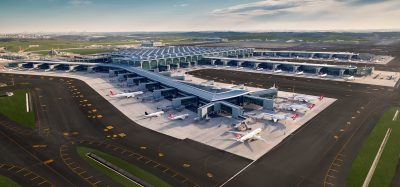Increased capacity, increased efficiency
- Like
- Digg
- Del
- Tumblr
- VKontakte
- Buffer
- Love This
- Odnoklassniki
- Meneame
- Blogger
- Amazon
- Yahoo Mail
- Gmail
- AOL
- Newsvine
- HackerNews
- Evernote
- MySpace
- Mail.ru
- Viadeo
- Line
- Comments
- Yummly
- SMS
- Viber
- Telegram
- Subscribe
- Skype
- Facebook Messenger
- Kakao
- LiveJournal
- Yammer
- Edgar
- Fintel
- Mix
- Instapaper
- Copy Link
Posted: 11 December 2009 | Dr. Francisco Severino, Lisbon Airport Director | No comments yet
Located on the Atlantic coast, at the western edge of Europe, Lisbon Airport is the ideal gateway for the growing traffic between Brazil, Africa and Europe. In 2008, Lisbon Airport handled 13.6 million passengers, almost 145 thousand landings and take-offs and more than 80 thousand tonnes of cargo. A 380 million-Euro development plan is under way. Working alongside its partners to improve its quality standards, Lisbon Airport is currently expanding its capacity to the maximum – 40/42 flight operations per hour – providing passengers with greater comfort and airlines with greater efficiency.
Located on the Atlantic coast, at the western edge of Europe, Lisbon Airport is the ideal gateway for the growing traffic between Brazil, Africa and Europe. In 2008, Lisbon Airport handled 13.6 million passengers, almost 145 thousand landings and take-offs and more than 80 thousand tonnes of cargo. A 380 million-Euro development plan is under way. Working alongside its partners to improve its quality standards, Lisbon Airport is currently expanding its capacity to the maximum – 40/42 flight operations per hour – providing passengers with greater comfort and airlines with greater efficiency.
Being a Star Alliance hub, with direct connections to more than 90 airports through 32 scheduled airlines and charter links to many others, Lisbon airport plays a vital role in facilitating local business and international trade.
Departure baggage terminal
There are 32 airlines operating in Lisbon, accounting for around 400 flight operations a day. On the peak days in the summer, there were as many as 55,000 incoming and outgoing passengers passing through Lisbon Airport. In order to cope with these numbers, we increased the capacity of our local baggage system to 4500 bags/hour.
Conveyors take the baggage from the check-in counters to five EDX machines, each one with a throughput of 900 pieces an hour, to ensure 100% screening. Bags that pass inspection levels 1, 2, or 3 are automatically delivered to the barcode-based automatic sorting system and then to the chute of the final destination flight. In total there are 42 chutes for departure flights in the main terminal.
In case of any security irregularity (time-out, suspicious/dangerous item) the baggage will be diverted to level 4 for a security recheck or even for reconciliation with the passenger if a doubt still persists.
The system is completely automatic and in the event of any failure, such as a tag missing from a bag or problems with BSM (Baggage Sorting Message), the affected pieces will be sent to manual encoding stations (MES) which re-encode them and make sure they are sent to the right chute. Besides pushers that actually “push” the bags to the chute, we also have trays that tilt at the right time, and the pieces just slip into the chute. This system is much quieter and avoids the problem of baggage jams, which sometimes lead to errors in delivery.
There are 107 check-in counters and the average time to process baggage is around 20 minutes from point to point, considering the longest route into the terminal.
During summer peak periods, LIS handles around 30,000 pieces a day in departures (Baggage Terminal 1 and 2). Another terminal (Baggage Terminal 3) with a single line, one EDX and one carousel, is used for premium passengers only, and a new terminal was opened in 2008 specifically for domestic flights (Terminal 2). Here, also, there is a single system feeding the line from the check-in counters through two EDX, ending in manual sorting on the final carousel, and making a total of five terminals in Lisbon (which includes departures, arrivals and transfers).
Another concern of Lisbon Airport is to ensure that everyone involved in the handling of the baggage (including the check-in personnel) know how the baggage handling system operates. This helps everyone to understand their role in this process, avoiding baggage jams and other problems. Several training sessions take place every year and results are always good. Lack of appropriate training can and does influence the performance of any system.
Keeping a close eye on the day to day operation is vital to the success of any baggage system. LIS has a tool in place that analyses the performance of the system – the number of bags processed, processing times, the level of security – based on BSMs (Baggage Sorting Message), etc., that allows the management to take measures and establish service level agreements with all the partners.
ANA expects the number of passengers at Lisbon Airport to rise to 18 million per year by the year 2017. In order to cope with the accompanying surge in the amount of baggage, the existing baggage handling system is to be expanded. The project calls for the installation of 56 new check-in counters, five baggage reclaim carousels and two output units for oversized baggage.
In addition, four transfer lines are to be installed with a total system length of 8.500 metres. 50 chutes, seven baggage carousels and one pre-sorting and two automatic distribution rings will be added to the existing system. The project includes all aspects of the mechanical and electrical installation, the provision of the Simatic control software and commissioning. Under the expansion plan, the capacity of the baggage terminal will increase to 8400 pieces per hour in 2011.
Arrival baggage terminal
In the baggage claim area there are eight carousels. This area was refurnished in 2008, to enhance the capacity and quality of service in four of the oldest carousels, and it will also be enlarged from eight to 12 carousels, bringing the airport to its maximum capacity.
Transfer baggage terminal
Lisbon Airport’s strategy takes into account the needs of its airline clients in general and TAP Portugal in particular, who represent almost 60% of the total amount of traffic. In 2002 TAP has decided to change LIS from a point to point airport to a hub airport. Therefore, the number of transfer passengers, and consequently the amount of transfer baggage, has grown gradually.
Besides the local traffic, LIS has to deal with the transfer traffic (passengers and baggage) and offer fast turnarounds to be competitive with other European hubs. Thus a Transfer Baggage Terminal (TBT) was built in 2004, which was improved last year with the adoption of RFID technology for sorting purposes. A work group was set up involving the airline company, the ground handler and the airport, as manager. The group drafted what we thought would be the appropriate solution. Service provider for this project was a consortium of Siemens and Lyngsoe Systems.
One of the major problems LIS had to face was the poor quality of printed tags coming from foreign locations in South America and Africa, as well as the lack of information related to BSM (Baggage Sorting Message). The need to solve these kinds of problems led LIS to RFID technology. The decision taken looks right, with 99.5% read rates.
This infrastructure makes it possible to speed up the whole process, diverting the bags from secure origins to “clean lines”, bypassing the x-ray machines. Thus, if a bag comes from Europe headed to Brazil, the system will send it directly to the chute without screening it, following the very strict security rules. Around 90% of bags will take less than five minutes to complete the entire process. The performance of this terminal depends on the performance of the staff stationed at the MES and at the chutes.
LIS is making real progress in terms of levels of mishandled baggage. As a result of great efforts on the part of all those involved in the industry, irregularities decreased almost 20% worldwide, which means that the industry saved almost 800 million dollars. LIS followed suit and at times exceeded the recommendations of the industry specialists, IATA/SITA, achieving values of 36 bags per 1000 passengers in 2008, as compared to 54.1 in 2007. Our average score in July was around 24.4. The goal for 2009 is set at 23.5 bags per 1000 passengers.
Some of the factors that contribute to attaining these fine results include improvements in the baggage processes and systems management (i.e.: New Transfer Baggage Terminal with sorting based on RFID Technology, BagManager SITA Reconciliation systems), as well as significant improvements in tracking and tracing technologies. However, the major factor was the Transfer Baggage Terminal. Since its opening in December 2008, it has already processed half a million pieces, in less than five minutes each, which has contributed greatly to the lower numbers of mishandled bags, by decreasing the BHS processing times, leaving more useful time for ramp operations.
RFID experience in Lisbon
Lisbon Airport is the first airport in the world to adopt RFID in transfer Baggage. In the baggage transfer process, an RFID tag (radio frequency identification) is attached to the bag when it arrives at Lisbon Airport and has to be transferred from one flight to another. Using this RFID tag, instead of barcode labels, enables us to handle the bag more efficiently and ensure it is on board the same aircraft as the passenger. Unlike the barcode label, the RFID tag can be used more than once.
When LIS started planning the new baggage transfer terminal, to increase the airport baggage handling capacity, the use of RFID technology instead of barcode labels to handle the transfer luggage was an obvious choice. RFID is considered to be the technology of the future for baggage handling, being recommended due to its reliability and efficient tracking capability. Lisbon Airport has taken the full step into the future and is the first airport in the world to handle transfer baggage solely with RFID technology and no barcode system.


















